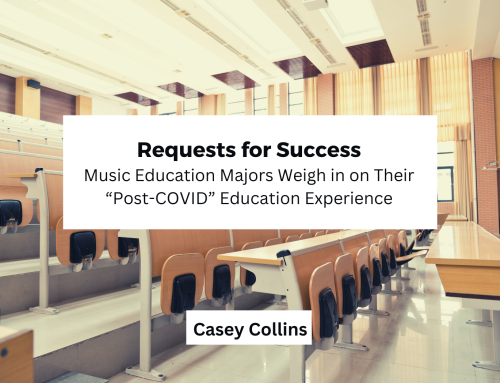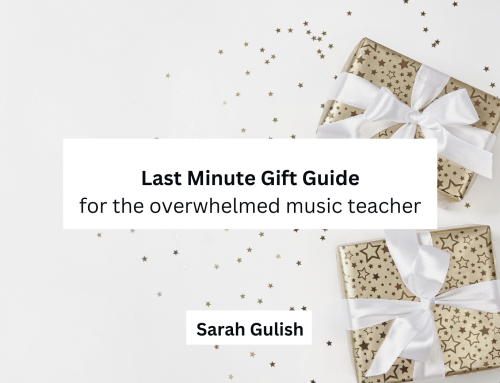Table of Contents
Using Data for More than Just Grades
I used to think that research was complicated and couldn’t help me in my classroom. I used to see the Music Educators Journal arrive in my mailbox, flip through, sigh, think to myself – “If I only had time….,” and then add the issue to a growing pile on my dining room table.
I also used to think that research served no purpose for current teachers.
…and then I started using research to back up why I taught my beginning students by rote when an administrator questioned my competency as a teacher. I needed something to back up my teaching decisions to prove to a non-musician that I did, in fact, know what I was doing. It was then that I also realized that there’s probably some research to help answer a lot of questions I had about teaching students.
Jump forward a few years, and now I’m one of those people doing research. Research that can help teachers in the very situation I was in. And I can fully acknowledge that about 90% of the research I’ve done is sitting in a well-organized folder on my desktop. Doing absolutely nothing. And I’m not alone. Professors, graduate students, teachers, Ph.D. students—we all have that folder. Topics we presented that won’t quite work for a research journal. Projects we did for a class. Data collected from students to prepare for yearly evaluations. All these projects took time to complete and could potentially help teachers.
Enter this column. I figured if there isn’t somewhere for all that research to go—if there isn’t a place that can connect research to practice for teachers—then I would have to create it. Well, actually, I figured I could do it with a little help from my friends at F-flat Books.
Published Research Doesn’t Have to be Scary
Have you ever used demographic information to track your student enrollment? Did you realize that your school likely already collects this information? This information is accessible at our schools, but us fancy researchers can also request access to the demographic information for graduating students nationwide.
Kenneth Elpus and Carlos Abril1(Elpus & Abril, 2019) looked at data available from the graduating class of 2013 who had enrolled in at least one year of band, choir, or orchestra during their high school career. And they were able to see a lot by looking at similar information from an earlier study of the graduating class of 2004.
What they Found
Elpus and Abril found that 24% of all graduating students in 2013 had enrolled in at least one music ensemble during their high school career. They also found that 3% of students had taken at least one guitar class, 3% had taken at least one piano class, and about eight-tenths of 1% of students had taken at least one music technology class.
The good news is that the 24% of graduates taking at least one music ensemble is higher than the 21% from the class of 2004. This shows a positive trend. We’re (hopefully) moving toward higher musical participation!
So what? Why Should you Care?
Choir was the most popular class at 13% enrollment, band was second at 11%, and orchestra clocked in at just 2%. The gap between 11% and 2% is pretty big. This study doesn’t explain the difference in participation, but it can lead you to ask some questions if your participation looks like this too. It can help you to think more about what types of classes you offer, consider how many music teachers are employed in your district, and most importantly, figure out what music classes are even offered for students to take and when. The numbers are just the numbers. Giving those numbers context involves a bit more investigating.
Though the specific demographic break-down is interesting to me, a self-proclaimed research nerd, it may not mean anything to you. What you may care about is how many students graduating from your school took a music class. And what those classes were. And if you had options for students who wanted to take classes like guitar, piano, music technology, music theory, modern band, mariachi, music production, etc. If you’re looking at your numbers and think to yourself, I could reach more students at my school(s), this information will help you know what steps you can take to refocus your recruitment. You can also use this information to better explain to your administrators your need for more music classes. It can help you use data to be a more effective advocate.
Though this information broken down by demographics nation-wide is interesting to me, it may not mean anything to you. What you may care about is if your school-wide demographics match those of your ensembles and classes. Elpus and Abril found that African American and Latino students were significantly underrepresented in instrumental music classes. If you find the same thing, what can you do? Are there students who could have received a formal music education but missed out? The only way to make sure you’re reaching as many students as you can is to look, really look, at what the numbers are telling you.
Using Research
Looking at crazy-big datasets may be interesting to me, but sometimes even for me, understanding what those numbers mean is complicated. Looking at smaller amounts of data collected in your school(s) or district may still be overwhelming. In the journal General Music Today, there is a great article written by Laura Dunbar2(Dunbar, 2020) that talks about how to analyze data using Microsoft Excel and Google Sheets. This is really helpful in showing you what to do with your collected data to turn it into something meaningful to you, your program, and your community. This article can help you figure out what to do once you collect information from your school. It won’t “run the numbers” for you or tell you what those numbers mean, but it can talk you through some steps to really figure out what is happening. Once those numbers make sense to actual humans, you can actually do things with them…like ask for more space, more resources, more class offerings next year; the list is endless!
Not all research is hard to read. Not all research is meant for people who already know what they’re doing. And most importantly, not all research is hard to understand. Some of it is, and I’ve made it my goal to break down those fancy terms into implementable ideas you can actually use in your classroom.
So, I’m going to continue to offer my services and find research that is worth decoding. I’m going to reach out to graduate students, Ph.D. students, music education faculty, and even current K-12 teachers who are doing research in their classrooms.
I want to know what research is out there! So, if you have research, let’s talk.
Do you have research to contribute to this column? Submit with this link so that I can share what you’ve created in a future post.
Articles Referenced
- Elpus, K. & Abril, C. R. (2019). Who enrolls in high school music? A national profile of U.S. students, 2009-2013. Journal of Research in Music Education, 67(3), 232-228. https://doi.org/10.1177/0022429419862837
- Dunbar, L. (2020). The other part of the job: Rapid data analysis with excel and sheets. General Music Today, 33(2), 83-86. https://doi.org/10.1177/1048371319880873




Go Elizabeth! This column is a terrific idea–your opening “why?” explanation resonates….I’m certain others will begin dusting off some of their research and sending it along. Congratulations, and very best wishes!